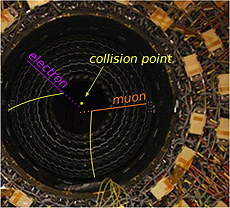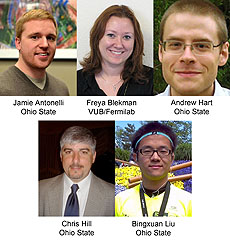Off the beaten path
 |
| Most particles produced by proton collisions originate in the point where the beams cross. Those that do not are due to intermediate particles that travel some distance before they decay. |
The main concern for most searches for rare phenomena is to control the backgrounds. Backgrounds are observations that resemble the one of interest, yet aren't. For instance, fool's gold is a background for gold prospectors. The main reason that the Higgs boson was hard to find is that most Higgs decays resemble b quark pair production, which is a million times more common. You not only have to find the one-in-a-million event picture, you have to identify some feature of it to prove that it is not an ordinary event.
This is particularly hard to do in proton collisions because protons break apart in messy ways — the quarks from the proton that missed each other generate a spray of particles that fly off just about everywhere. Look through a billion or a trillion of these splatter events and you can find one that resembles the pattern of new physics that you're looking for. Physicists have many techniques for filtering out these backgrounds — requiring missing momentum from an invisible particle, high energy perpendicular to the beam, a resonance at a single energy, and the presence of electrons and muons are just a few.
A less common yet powerful technique for eliminating backgrounds is to look for displaced particle trajectories, meaning trajectories that don't intersect the collision point. Particles that are directly created by the proton collision or are created by short-lived intermediates always emerge from this point. Those that emerge from some other point in space must be due to a long-lived intermediate.
A common example of this is the b quark, which can live as long as a trillionth of a second before decaying into visible particles. That might not sound like very long, but the quark is traveling so quickly that it covers several millimeters in that trillionth of a second, which is a measurable difference.
In a recent analysis, CMS scientists searched for displaced electrons and muons. Displaced tracks are rare, and electrons and muons are also rare, so displaced electrons and muons should be extremely rare. The only problem with this logic is that b quarks sometimes produce electrons and muons, so one other feature is needed to disambiguate. A b quark almost always produces a jet of particles, so this search for new physics also required that the electrons and muons were not close to jets.
With these simple selection criteria, the experimenters found only as many events as would be expected from standard physics. Therefore, it constrains any theory that predicts displaced electrons and muons. One of these is "displaced supersymmetry," which generalizes the usual supersymmetry scenario by allowing the longest-lived supersymmetric particle to decay on the millimeter scale that this analysis tests. Displaced supersymmetry was introduced as a way that supersymmetry might exist yet be missed by most other analyses. Experiments like this one illuminate the dark corners in which supersymmetry might be hiding.
—Jim Pivarski
 |
| These U.S. physicists contributed to this analysis. |
 |
| These members of the Scintillation Detector Development Group at Fermilab are working to invent new scintillator materials to be used for upgrades of the CMS calorimeters.
|
|